Izzet Phoenix Deck Guide
Intro
It’s been years since Arclight Phoenix was first printed in Guilds of Ravnica, and during that time this card lifted decks of various formats into prominence. In Modern, we saw Faithless Looting banned to contain the ever-growing list of cards that abused the one-mana spell – and Arclight Phoenix being the prime suspect. While Pioneer has never had an enabler quite like Looting, we have seen Arclight Phoenix continue as a top deck through every metagame shift. efficient threats, removal and card draw gives this deck a near limitless skill cap and top players have found success making small tweaks to address any potential matchup.
Arclight Phoenix is one of the best recursive threats we have seen in Magic and gives this deck endless endgame threat.
We’ve seen the deck evolve several times recently, including overcoming an Expressive Iteration ban that threatened to finally knock Phoenix down a peg. With the addition of Temporal Trespass, we’ve seen Phoenix continue to hold a top spot in the metagame as dealing with recursive threats that can stack damage over a few extra turns is difficult for any deck to overcome regularly.
Let’s look at this consistent and powerful deck that is a piece of the core pillars of Pioneer today!
Deck List
Deck Breakdown
Creatures
The printing of Ledger Shredder in Streets of New Capenna was a huge upgrade for Arclight Phoenix. While the deck was previously all-in on Thing in the Ice, this new threat helps to shore up several aggressive matchups while giving an additional flying threat. The repeated card selection can also help you smooth out your draws, especially in matchups that normally start off quickly, since the earlier you or your opponent double-spell, the more powerful Shredder gets. While Shredder isn’t the most imposing threat by itself, once you’ve faced it a few times as a 3/5 or larger, you will start to feel the pressure of their two-drop killing you by itself.
Thing in the Ice was once the all-star of the deck but has since been relegated to a role-player that helps to manage the aggressive matchups and the matchups where resetting the board is incredibly important. While Thing is less potent in Pioneer right now, this slot is a place to constantly check in on to see if you may want additional copies to help against certain matchups. Granted, the prevalence of black removal, exile effects, and cards like Brutal Cathar has left Thing in the Ice a shell of its former self.
What more is there to add about Arclight Phoenix? It is one of the best recursive threats we have seen in Magic and gives this deck endless endgame threat, especially when paired with Temporal Trespass. Few things feel as scary as seeing multiple Arclight Phoenixes hitting the graveyard early and knowing that they will come back soon to threaten your life total or Planeswalkers. The power of Arclight Phoenix is one of the reasons this deck has persisted for so long and that isn’t changing anytime soon.
Removal
Paired with the various creatures in the deck, there’s a laundry list of red removal used to help keep Aggro decks in check, stop ramp decks from pulling too far ahead, and ensure that you can pivot into the more controlling role against various styles of decks. While most of the removal in this deck is simply damage-based, Lightning Axe manages to double as a discard outlet for Arclight Phoenix, allowing you to kill a creature and set up a future threat. Lava Coil and Fiery Impulse work top keep the board clear, especially since three and four toughness are massive breakpoints for creatures in Pioneer. Along with Lava Coil, Spikefield Hazard allows you to exile threats that recur like
While not traditional removal, the deck also plays Spell Pierce to interact early with Planeswalkers and other non-creature threats that otherwise would dodge the red removal of the deck.
Card Advantage
One of the ways that Arclight Phoenix punishes the various decks of the format is through continuous card advantage and selection limiting the downside to running potentially situational cards like Spell Pierce or red removal. Cards like Consider and Opt allow you to filter through your deck, while Consider also helps enable Delve and Arclight Phoenix. These cheap cantrips are a big reason that you can recur Phoenixes easily or trigger Thing in the Ice and Ledger Shredder effortlessly. They may seem potentially low impact, but their synergy with the deck makes up for it in spades.
Chart a Course has seen a reduction in copies over the years as cards like Consider are just more effective, but it still has a slot in the deck to help discard cards like Arclight Phoenix and it can work well against decks that keep your graveyard under control as a two-mana draw two. While not too exciting, it is another form of card advantage that helps you in the early to mid-game.
Finally, we have Pieces of the Puzzle, which is the deck’s best delve enabler and helps you churn through your deck, finding various removal spells and threats to put into the graveyard. While the number of Pieces of the Puzzle started at a lower number, over time it has become a staple four-of and for good reason too. It is one of the best spells in the format at seemingly doing everything this deck wants to do in digging to specific spells, putting Arclight Phoenix in the graveyard, and enabling six delve spells.
Delve Spells
The delve spells have long been the poster children for ban discussions since early in Pioneer’s history. The long history of Treasure Cruise and Dig Through Time don’t bare repeating here, but we have seen them dominate World Championships and eat bans in nearly every competitive format. Pioneer is one of the last bastions where you can play these powerful delve spells and as such, they more than prove their merit.
Treasure Cruise is an incredible tool that always feels like it turns the game from close to a blowout. Drawing three cards is a ton, especially when most of your deck generates more advantage. Add in the fact that you can leverage the speed that this deck fills the graveyard to cast Cruise early and often and you suddenly are way ahead of every deck in terms of card advantage. It’s no shock to learn that Treasure Cruise is an all-star and continues to warrant ban discussion every few months.
The more shocking delve spell to see play in this deck is Temporal Trespass. This card saw little to no play for the longest time until the Standard Izzet Turns deck came to prominence. This deck leveraged Alrund’s Epiphany alongside Galvanic Iteration and treasure tokens to make enough mana to take several turns in a row. Some very smart Pioneer players figured they could do a similar trick with Temporal Trespass, and they were very correct. Taking one extra turn in Pioneer is a lot. Taking two in a row is absurd. Taking three in a row is “good game” in just about any circumstance. This addition to Phoenix greatly helped give the deck inevitability, especially against some of the more controlling decks in the format.
Hall of Storm Giants
Your major threat outside of your creature, Hall of Storm Giants has long solidified itself as a great weapon for any deck that wants to get to the mid to late game to kill quickly. Pair this up with one Phoenix, and you can attack for twenty in two turns.
Remember those extra turns I talked about? Hall of Storm Giants is one of the easiest ways to close out the game during those extra turns as it is such a large and hard to answer threat, that if your opponent taps too low or doesn’t have adequate blockers, you can just end the game in an instant. This creature land was another major level up for Phoenix and remains a major reason the deck can dominate the late game, even against decks that can answer the two-drop threats.
Sideboard Guide
Rakdos Midrange
+1 Narset's Reversal, +2 Young Pyromancer, +1 Saheeli, Sublime Artificer, +1 Jace, Wielder of Mysteries
-1 Thing in the Ice, -2 Lightning Axe, -1 Galvanic Iteration, -1 Temporal Trespass
Matchup Feel: Tough
Matchup Approach: It can be tough to keep up with Rakdos’ two-for-ones. Especially the various Planeswalkers, Fable of the Mirror-Breaker, and Graveyard Trespasser. In this matchup, you need to keep the board clear while developing your own threats, but two-drop creatures are in grave danger here. I prefer Pyromancer to Thing here as you can play a spell or two and force them to remove multiple creatures, whereas Thing dying to Fatal Push without getting any value is tough. Try to hold your cards until you can get maximum value and churn through as many cards as you can. Be careful of Unlicensed Hearse, Kroxa, Titan of Death's Hunger, and Go Blank. All these cards can set you behind and give the agency to Rakdos, which is hard to overcome.
Originally, I liked this matchup for Phoenix, but the more I have seen and played of it, I lean towards the side of Rakdos being generally favored, especially post-board. If you can snag game one, you are much more likely to find a way to scrape through one post-board game, but Rakdos is one of the few decks that can adjust more than Phoenix for the post-board games.
Heroic
+1 Rending Volley, +2 Abrade, +1 Aether Gust, +1 Thing in the Ice, +2 Young Pyromancer, +1 Saheeli, Sublime Artificer
-2 Galvanic Iteration, -2 Temporal Trespass, -3 Pieces of the Puzzle, -1 Treasure Cruise
Matchup Feel: Close, but favorable
Matchup Approach: You need to kill everything. If you can’t kill it, try to leverage your recursive blockers or powerful defensive tools like Thing in the Ice. Reckless Rage is a tough card to deal with along with Gods Willing. If you can navigate those cards well, you can put them in a position where they have plenty of dead cards waiting for a creature.
Post-board, you need to watch out for threats like Adanto Vanguard and Showdown of the Skalds that help Heroic generate massive value and grind through your value. The later the game goes, the more favored Phoenix becomes, but you still need to respect lots of damage out of seemingly nowhere if a creature survives a single turn.
Azorius Control
+3 Disdainful Stroke, +2 Young Pyromancer, +2 Mystical Dispute, +1 Saheeli, Sublime Artificer, +1 Jace, Wielder of Mysteries
-1 Thing in the Ice, -4 Fiery Impulse, -2 Lightning Axe, -1 Lava Coil, -1 Spikefield Hazard
Matchup Feel: Close, but favorable depending on sideboard plans
Matchup Approach: Game one, you are overloaded with some dead cards, but you have plenty of ways to filter through them and get to your correct threats. If you can find your Hall of Storm Giants and run them out of resources, a Galvanic Iteration can help force through a key Temporal Trespass to end the game or a Treasure Cruise to pull ahead.
The Wandering Emperor, Dovin's Veto, and March of Otherworldly Light can make this matchup into a long affair where you must pivot from your primary threats, into more Planeswalkers and tokens. Even though Azorius can sweep up your tokens, you don’t have to commit many resources into forcing a wrath, allowing you to redeploy more threats immediately. Post-board, you can end the game with any of your threats and some key counterspells.
Leverage your proactivity to force them to have all the right answers at all the right times, while you get to craft your next moves with additional cantrips.
Abzan Greasefang
+1 Rending Volley, +2 Abrade, +1 Narset's Reversal, +1 Thing in the Ice
-1 Lava Coil, -2 Galvanic Iteration, -2 Temporal Trespass
Matchup Feel: Close, but unfavorable.
Matchup Approach: You need to constantly have multiple pieces of three-damage removal ready to go. Strong Greasefang pilots will wait for a discard spell before going for their Greasefang, so if you are relying on a single piece of interaction, you will likely lose. Given you have no access to graveyard hate in this style of builds, you do need to rely on a multitude of instant speed removal. You’ll need to carefully line up your turns around their ability to play Greasefang and even bring it back with Can't Stay Away .
Having access to instant speed Thing in the Ice flips can also help to slow down key turns from Greasefang so you can rebuild your hand to adequately answer their potential threats. Ideally, you want to get ahead on board and then coast across the finish line while they spin their wheels looking for more Greasefang or Can't Stay Away after you answer the first few.
Mirror
+1 Rending Volley, +2 Mystical Dispute, +1 Jace, Wielder of Mysteries
-1 Thing in the Ice, -2 Chart a Course, -1 Lightning Axe
Matchup Feel: Are you more skilled?
Matchup Approach: This matchup is tough. You both can kill most creatures and leverage massive amounts of card advantage to put the opponent in a bad spot if they ever fall behind. Leverage your counterspells and strap in for a long game of grinding out slight advantages. Even though Jace isn’t likely to win the game, getting repeated value out of a hard to kill permanent can easily pull you ahead.
Filling your graveyard before taking advantage of your delve spells alongside counterspells since the delve spells end up so cheap allows you to take tempo advantages. The first big spell to resolve can often snowball the game, so pick your spots carefully.
Mono-Red
+2 Abrade, +1 Aether Gust, +1 Thing in the Ice, +1 Saheeli, Sublime Artificer
-2 Galvanic Iteration, -2 Temporal Trespass, -1 Treasure Cruise
Matchup Feel: Close, but unfavorable.
Matchup Approach: While you can take over the mid to late game, the quantity of burn in Mono-Red leads to an inevitability that will often kill you even when you’re in control of the game. Cards like Ledger Shredder help you close quicker, but it still requires two or more turns to get out range of Rending Volley or Lava Coil.
The Cleave version is a little slower and is easier to deal with each of the creatures on time than the smaller red version that leverages more burn and Planeswalkers for repeatable damage. Try to deal with Eidolon of the Great Revel on sight and be careful of Kumano Faces Kakkazan, especially since it can permanently exile your Arclight Phoenixes, drastically cutting your ability to close out the game.
Mono-Green Devotion
+2 Abrade, +1 Aether Gust, +3 Disdainful Stroke, +1 Thing in the Ice
-2 Chart a Course, -2 Galvanic Iteration, -1 Temporal Trespass, -2 Arclight Phoenix
Matchup Feel: Unfavorable game one, favored games two and three.
Matchup Approach: Two-drops are key in this matchup. You need a two-drop on turn two and to remove as much of their ramp as possible. If you can keep their key spells from resolving and reset their progress with Thing in the Ice, you can easily tempo them out of the game. You do not have inevitability here, so you need to be the aggressor in closing out the game. While it may seem odd to trim Phoenixes, they don’t do enough early and the recursive gameplan is great, but often suffers in the face of Karn, the Great Creator keeping the graveyard from filling up too much.
With the addition of Portable Hole in the bant devotion shells, it can be much harder to close out the game versus Green, especially since turn two Thing in the Ice is much less likely to end the game. If you have an early Thing on board, play to protect it as it can solo win the game. This is a matchup that takes some time to get down but is a major reason Phoenix continues to sit in the top tiers of Pioneer.
Mono-White Humans
+1 Rending Volley, +2 Abrade, +1 Thing in the Ice, +2 Young Pyromancer, +1 Saheeli, Sublime Artificer
-2 Galvanic Iteration, -2 Temporal Trespass, -1 Pieces of the Puzzle, 2 Treasure Cruise
Matchup Feel: Favored
Matchup Approach: Your main goal is to kill all their relevant creatures and pivot to the Young Pyromancer plan, so you aren’t reliant on your graveyard. Leverage your cheap and efficient removal and plan around cards like Thalia, Guardian of Thraben, Brave the Elements, and the various protection effects. If you can kill their key creatures and build a wide enough defensive board state, it becomes nearly impossible for them to kill you without Brave the Elements.
Leverage Thing in the Ice and Ledger Shredder to stunt early aggression and make their early development awkward. If you can keep them off tempo and kill key threats, you should easily be able to take over the mid to late game.
Mono-Blue Spirits
+1 Rending Volley, +2 Abrade, +2 Mystical Dispute
-1 Thing in the Ice, -2 Temporal Trespass, -1 Pieces of the Puzzle
Matchup Feel: Favored
Matchup Approach: Like with Mono-White, you need to navigate some protection in the form of Mausoleum Wanderer, Rattlechains, and counterspells. You need to contain the early aggression from Mono-Blue and leverage your powerful threats that can trade or eat various spirits like Arclight Phoenix and Ledger Shredder. If you can sneak a Shredder into play, it can easily stop spirits for long enough for you to find interaction and counterspells.
Your favorable matchup against Spirits is a big reason that Spirits comes and goes at the top of the meta as it can handle some of the bigger mana decks, but Phoenix does a great job of keeping the deck in check.
Tips and Tricks
· Try to play your pathways on blue. You will usually need more blue mana than red mana in this deck, especially when trying to cast Temporal Trespass.
· You can cast Galvanic Iteration and then flash it back to get two copies of your next spell. This is particularly strong with the delve spells.
· You can pay the extra tax from Damping Sphere, God-Pharaoh's Statue, or Thalia, Guardian of Thraben via delving extra cards from your graveyard.
· Arclight Phoenixes don’t need to see previous spells to come back. So, if you discard a Phoenix to your third spell for the turn, it will still recur at beginning of combat.
· Fiery Impulse checks spell mastery on resolution. So, if you have one spell in the graveyard, you can target something with ward – like Graveyard Trespasser, and you can discard a spell to turn on the three-damage mode.
· Pivoting between different post-board strategies in games two and three can help keep opponents from properly adapting their sideboard strategy. Don’t get too cute with it but consider when you want to play around various hate cards based on what threats you have in your deck.
· Against decks where you suspect they may have a counterspell, you can leverage Galvanic Iteration to copy your spell, requiring two counterspells to hit both copies. This is especially effective with Treasure Cruise or Removal.
· Thing in the Ice bounces all non-horror creatures, so take note of any horrors on the board like Woe Strider when considering your flip turns.
· Against graveyard hate, don’t forget you can use Chart a Course as a pure draw two. You don’t need to always discard, especially in matchups where having more resources can be beneficial, like against Rakdos.
Wrapping Up
There you have it, a breakdown of Izzet Arclight Phoenix – one of the premier decks of Pioneer that every player needs familiarity both with and against if you want to do well in higher level competition. While we have seen Phoenix have troughs and peaks in the metagame, it is a deck that guarantees a ton of agency and will always lead to strong players winning matches. This is especially true at local events and the deck’s power level scales relative to the skill gaps you can leverage thanks to having constant decision trees and places to gain incremental advantage. Put the time into Phoenix and you will see the results start to roll in quickly and without break.
Thanks for reading and be sure to stay safe out there!


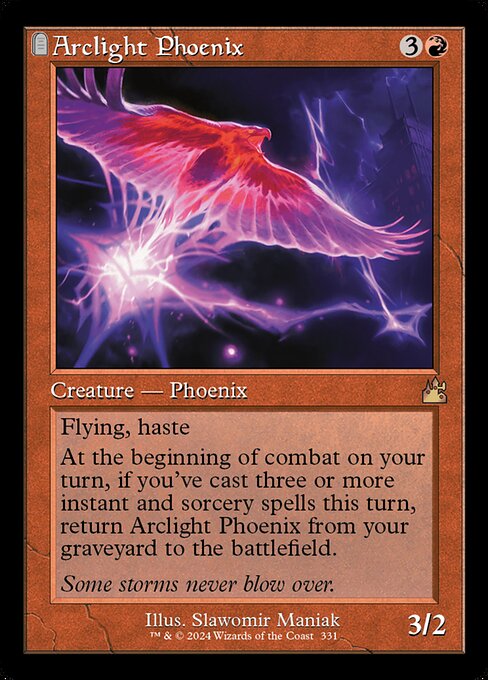
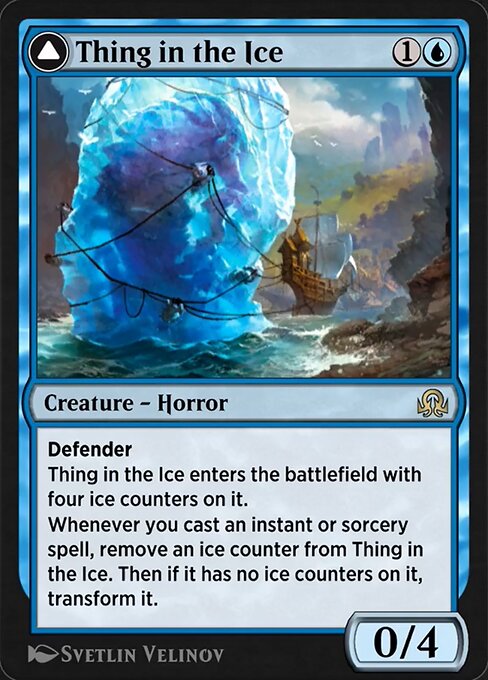


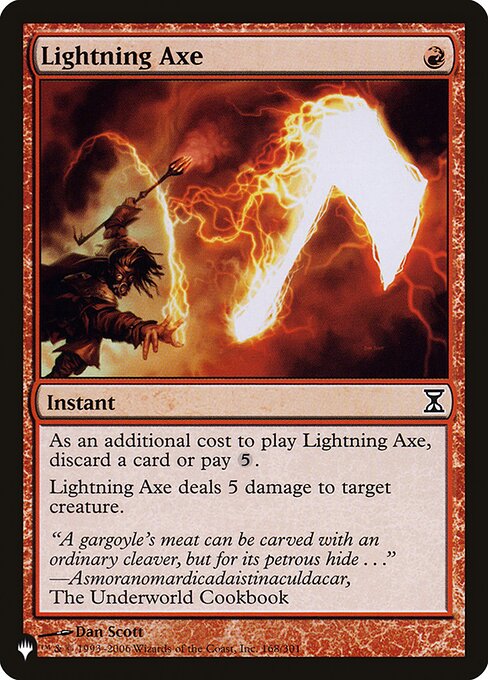
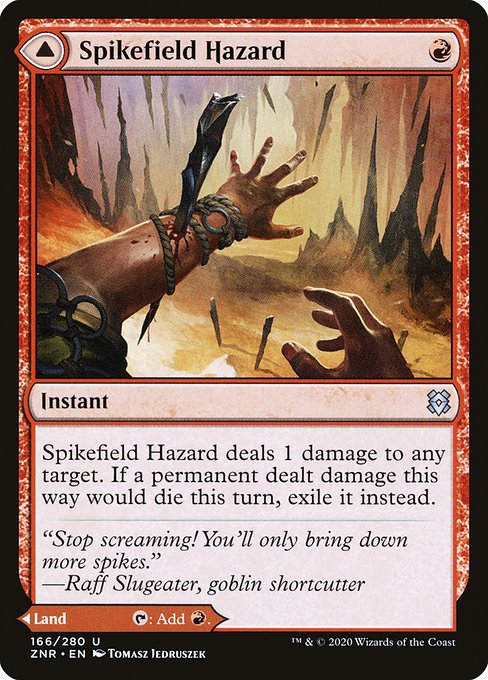

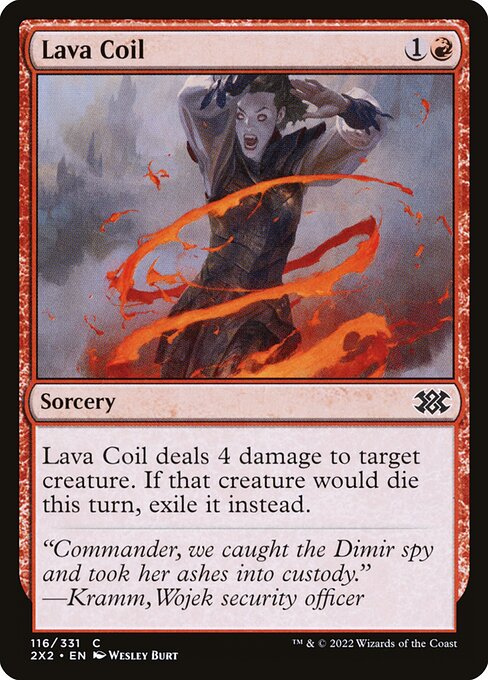

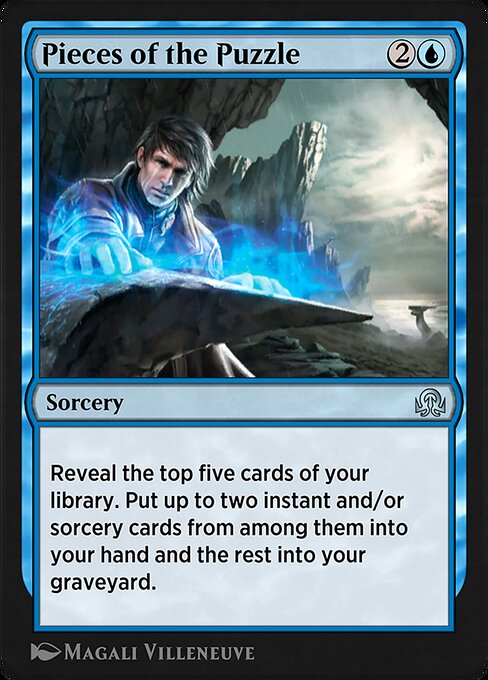
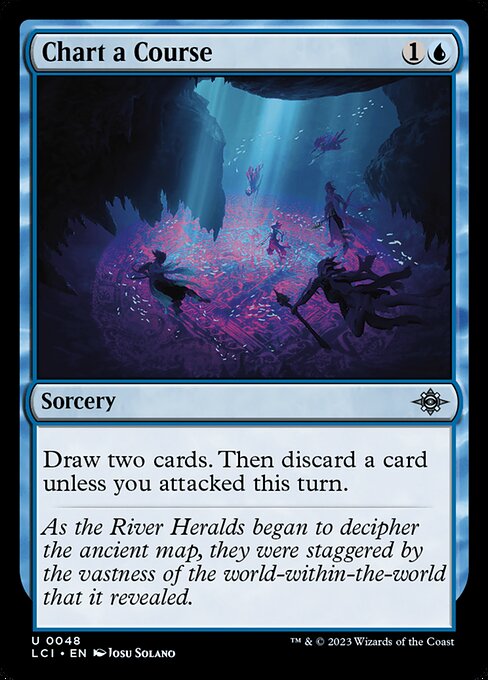

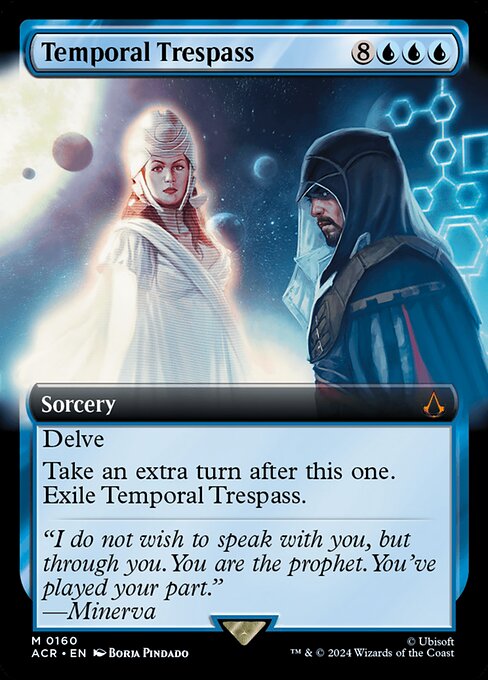


The new version of Phoenix breaks the meta, so I’m eagerly waiting for the new guide)